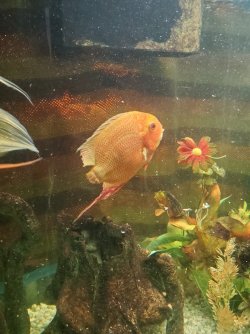BASIC FIRST AID FOR FISH
Test the water for ammonia, nitrite, nitrate and pH.
Wipe the inside of the glass down with a clean fish sponge. This removes the biofilm on the glass and the biofilm will contain lots of harmful bacteria, fungus, protozoans and various other microscopic life forms.
Do a 75% water change and gravel clean the substrate every day for a week or until the problem is identified. The water changes and gravel cleaning will reduce the number of disease organisms in the water and provide a cleaner environment for the fish to recover in. It also removes a lot of the gunk and this means any medication can work on treating the fish instead of being wasted killing the pathogens in the gunk.
Make sure any new water is free of chlorine/ chloramine before it is added to the tank.
Clean the filter if it hasn't been done in the last 2 weeks. However, if the filter is less than 6 weeks old, do not clean it. Wash the filter materials/ media in a bucket of tank water and re-use the media. Tip the bucket of dirty water on the garden/ lawn. Cleaning the filter means less gunk and cleaner water with fewer pathogens so any medication (if needed) will work more effectively on the fish.
Increase surface turbulence/ aeration to maximise the dissolved oxygen in the water.
Post clear pictures and video of the fish so we can check them for diseases.
---------------------
NITRATES
If you have high nitrates, and I expect you do with a 14 inch redtail catfish and 10 other fish in a 6ft tank, your cichlids are at risk of developing hole in the head disease, as well as various other health issues. You need to keep nitrates as close to 0ppm as possible, and under 20ppm at all times.
Gravel should be cleaned every time you do a water change.
Established Filters should be cleaned at least once a month.
I'm not sure how old the redtail catfish is, but under good conditions they can grow to 18 inches long in 6 months. Over time they can reach 3-5 feet long, females being bigger than males. I am hoping you have a pond or something to house the fish in when it gets bigger.
---------------------
FIN ROT
Fin rot is caused by poor water quality that damages the tissue and allows harmful bacteria into the wounds, where more damage occurs. Treatment is normally clean water and salt. Your severum has an advanced case and salt might not be enough. If salt doesn't help within a few days, you will need a broad spectrum medication that treats fungus and bacteria (preferably not an antibiotic).
Do a 75% water change and gravel clean the substrate every day for at least one, preferably two weeks.
Make sure any new water is free of chlorine/ chloramine before it's added to the aquarium.
If your water holding tank only holds 40% of the big tank's volume, do the 75% water change and use the water that is in the 60 gallon tank to partially fill the main tank, then refill the 60 gallon, add dechlorinater, aerate for 30 minutes, then finish filling the main tank.
Add some salt, (see directions below). For a big tank getting daily water changes, it is probably cheaper to visit a hardware store or swimming pool shop and buy a 10-20kg (22-44 pound) bag of pool salt. Use the salt for at least one (preferably two) week and see how the fish are doing. If the fins don't appear any better after a few days, post more pictures. If it isn't noticeably better after a week, use a broad spectrum medication.
---------------------
SALT
You can add rock salt (often sold as aquarium salt), swimming pool salt, or any non iodised salt (sodium chloride) to the aquarium at the dose rate of 1 heaped tablespoon per 20 litres (5 gallons) of water. If there is no improvement after 48 hours you can double that dose rate so there is 2 heaped tablespoons of salt per 20 litres.
Keep the salt level like this for at least 2 weeks but no longer than 4 weeks otherwise kidney damage can occur. Kidney damage is more likely to occur in fish from soft water (tetras, Corydoras, angelfish, Bettas & gouramis, loaches) that are exposed to high levels of salt for an extended period of time, and is not an issue with livebearers, rainbowfish or other salt tolerant species.
The salt will not affect the beneficial filter bacteria, fish, plants, shrimp or snails.
After you use salt and the fish have recovered, you do a 10% water change each day for a week using only fresh water that has been dechlorinated. Then do a 20% water change each day for a week. Then you can do bigger water changes after that. This dilutes the salt out of the tank slowly so it doesn't harm the fish.
When you do water changes while using salt, you need to treat the new water with salt before adding it to the tank. This will keep the salt level stable in the tank and minimise stress on the fish. You will have to add enough salt to treat the 60 gallon holding tank and aerate it for 30 minutes before using that water in the main tank.
When you first add salt, add the salt to a bucket of tank water and dissolve the salt. Then slowly pour the salt water into the tank near the filter outlet. Add the salt over a couple of minutes.





